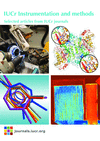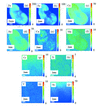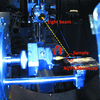issue contents
September 2017 issue

Cover illustration: Simulated local degree of coherence (top figures) and the absolute value of the mutual optical intensity (MOI) function (bottom figures) between every two points on the horizontal axis at the image plane of a focusing mirror (see Meng, Shi, Wang, Reininger, Assoufid and Tai, pages 954-962. The MOI propagation model is extended to include the simulation of partially coherent radiation through non-ideal mirrors. The effects of figure errors are shown in the right-hand figures.
facility information
editorial
Free 

The IUCr, which was established 70 years ago, will be celebrating 70 years of peer-reviewed publications in 2018. Three of its journals, including IUCrJ, are ranked in the top 10% of all journals, with the remainder striving to be in the top quartile in the next five years.
research papers
By using the natural field gradient of a normal planar undulator as the modulator field for a phase-merging enhanced harmonic generation free-electron laser (FEL), almost the same FEL performance can be achieved.
Open  access
access
 access
accessThe influence of higher-harmonic free-electron laser oscillations on an electron beam have been clarified by measuring the bunch length of the electron beam.
The refurbishment of a used in-vacuum undulator with necessary improvement for a more modern light source is described.
Open  access
access
 access
accessTime-resolved finite-element modelling is used to study the sample heating from intense X-ray irradiation.
An optical vortex beam carrying an orbital angular momentum of  (l = ±1) per photon was produced as the second-harmonic radiation from a helical undulator. The helical wavefront of the optical vortex beam was verified though an interference experiment.
(l = ±1) per photon was produced as the second-harmonic radiation from a helical undulator. The helical wavefront of the optical vortex beam was verified though an interference experiment.
The absolute flux distribution for a polychromatic synchrotron X-ray beam is obtained from an extensive set of accurate filter-transmission measurements. The technique is also demonstrated for a monochromatic X-ray beam for which there is significant harmonic contamination.
A simulation method based on the mutual optical intensity model is developed for simulating the propagation of partially coherent radiation through non-ideal mirrors.
The use of the EIGER Si hybrid pixel detector as a detector for low-energy electrons in PEEM experiments is reported. EIGER is characterised by a high signal-to-noise ratio, high dynamic range, high spatial resolution and endurance, characteristics that makes it particularly suited for electron and X-ray spectromicroscopes operated at large-scale synchrotron facilities.
Temperature-dependent multilayer structure and cross-plane thermal conductivity are measured for multilayers with different periodic thicknesses.
Open  access
access
 access
accessThe application of the synchrotron-radiation-based coherent nanobeam X-ray diffraction method to study the type, quantity and the exact distances in between stacking faults in single GaAs nanowires is demonstrated.
A complete set of data is presented, acquired using the Flyscan method after injection of gold-cluster-enriched mesoporous silica nanospheres, used as potential theranostic vectors, into rats.
The coloration mechanism of sacrificial red glaze has been investigated using confocal depth-resolved micro-X-ray absorption spectroscopy at the 1W2B beamline of the Beijing Synchrotron Radiation Facility.
Line-shape analysis of a Compton-scattered X-ray energy spectrum has revealed the Li concentration in a battery under in operando conditions.
The local structure around In atoms in an m-plane In0.06Ga0.94N film coherently grown on a freestanding m-plane GaN substrate was investigated by polarization-dependent XAFS measurements. A step-by-step fitting procedure was proposed for the m-plane wurtzite structure.
The native oxide layer of silicon nanoparticles milled for different durations has been studied. The evolution of the sub-oxide states changes from the Si +4 state to a silicon monoxide state.
A protocol for objectively and automatically identifying the most probable electron density map from phase-retrieval calculations in coherent X-ray diffraction imaging is proposed.
Open  access
access
 access
accessSynchrotron-radiation-based microvascular hemodynamic analysis was established in this study. Tumor vasculature analysis using this method showed unique characteristics of tumor blood flow in vivo.
A new micro-beam Laue diffraction approach for the rapid, reliable alignment of multi-reflection Bragg coherent diffraction imaging measurements of arbitrarily oriented micro-crystals is presented. This approach is used to map out the full 3D-resolved lattice strain and stress tensors in a focused ion beam machined micro-crystal.
Synchrotron X-ray microtomography non-destructively maps demineralization within carious rat molar enamel. Depth profile analysis and lesion characterization reveals that many rat carious lesions possess intact surface zones that are similar in form but much thinner than those found in human caries.
The proposed Materials Segmentation and Metrics (MSM) dataflow provides protocols to systematically analyze and compare the results of unsupervised classification methods used for segmentation of synchrotron-based imaging. MSM offers different metrics to evaluate the performance of image segmentation algorithms in terms of quality, confidence and conformity with standards.
short communications
Open  access
access
 access
accessX-ray ptychography is being utilized for a wide range of imaging experiments with a resolution beyond the limit of the X-ray optics used. Here, strategies for data sampling and for increasing imaging throughput when the specimen is at the focus of an X-ray beam are discussed, and the tradeoffs between large and small illumination spots are examined.
The gating uniformity of Pilatus area X-ray detectors was characterized using synchrotron radiation. Gating offsets of more than 15 ns were observed between different modules of a Pilatus300K-W detector.
Open  access
access
 access
accessNanosecond pump–probe device for time-resolved serial femtosecond crystallography developed at SACLA
A nanosecond pump–probe device for time-resolved serial femtosecond crystallography has been developed at SACLA.
An under-diagnosed detector artifact is reported and corrected for in a sparse photon-counting regime. Standard deviation in false-positive photon count is reduced by up to 35%, with improved or identical true positive rates.
beamlines
A setup for total scattering experiments at the multi-purpose XDS beamline of the Brazilian Synchrotron Light Laboratory (LNLS) is described. Also, a preliminary characterization of the Pb1–xLaxZr0.40Ti0.60O3 (x = 0.11, 0.12 and 0.15) ferroelectric system using pair distribution function analysis is presented.
computer programs
WIFIP is a web-based interface for macromolecular crystallography beamlines. In operation on beamline FIP-BM30A at the ESRF since September 2015, it enables the control of the experiment remotely from any kind of web browser, and with a limited bandwidth.
addenda and errata
Free 

A correction to one of the equations in the paper by Sutter et al. (2012). [J. Synchrotron Rad. 19, 960–968] is made.


 journal menu
journal menu


















































